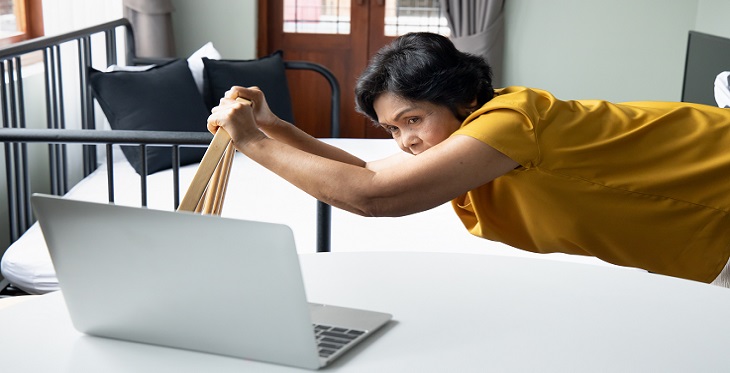For physical therapist Tony Kottoor, telehealth was cool long before the Covid pandemic made his peers and other health providers rush to find options for patients when face-to-face was no longer possible.
“I’m probably a bit of an anomaly and kind of unique in that I became fascinated with telehealth in 2017 when I did my capstone research for my physical therapy doctorate program,” Kottoor said.
The research, which focused on using telehealth in physical therapy and rehabilitation, took him to India and Colombia where he saw the difference it made, especially in rural communities, improving health outcomes for patients with great difficulty traveling to specialists and other doctors.
“I saw early on that when you compare the outcomes of in-person to telehealth, depending on the condition, patients can absolutely thrive with telehealth treatments,” Kottoor said.
Kottoor, who has his own practice in Phoenix, earned his bachelors at Loyola Marymount and went on to do a masters in kinesiology at California State University. He completed a specialized business certification at Oxford University, and thought he was done with his education.
“I thought I was in my ideal job, but then I got injured and I had to have sixty surgeries on my knee. I didn't walk for a year,” Kottoor said. “I was inspired to change careers.”
He went back to college for another five years to study physical therapy.
“I realized from personal experience just how powerful a difference a physical therapist can make in one’s life. For me it was physical freedom … as well as emotional wellness and quality of life.”
After graduating with his doctorate from Northern Arizona University, he joined a physical therapy practice in Phoenix and within a year he became director of clinical operations. With his telehealth background, Kottoor created a program for his company “from scratch. It was the best learning opportunity I could ask for.”
Ultimately, the triaging component is the most important first step when a perspective patient reaches out, and it’s also what makes many providers most nervous when trying to determine if this person is a candidate for telehealth or better suited for in-person.
“That uncertainly can feel like a liability,” Kottoor said. “You know the F word for a physical therapist is fall. If we are working to improve someone’s balance, how do you navigate that in telehealth?”
Well, for Kottoor, putting protocols in place for a telehealth program starts with a checklist to make sure you do your due diligence. “Are they a fall risk? Are you working on preventing future falls? Is there a caregiver present or a family member present that can be trained to help guard the patient or help them regain their balance if they were to lose it?”
“They seem like simple steps, but I’ve noticed that they certainly decreased the resistance from providers unsure about telehealth.”
Of course, a public health emergency like the Covid pandemic opened the telehealth box for providers that had never used telehealth technologies to work with patients. Kottoor said while he welcomed the change and had some protocols in place, convincing providers at his clinic was an effort in his new position as director of clinical operations for an outpatient physical therapy company with 20 locations throughout Arizona.
“It felt like everyone was scrambling. Not me,” he said, laughing. “My wife makes fun of me by pointing out my resume that mentioned telehealth three times. In the beginning of my career I wasn’t just promoting myself as a physical therapist, I was also promoting myself as a telehealth specialist at the time because it wasn’t a thing in physical therapy, but I knew it could and should be.”
Quickly, as lockdown started, Kottoor said he went from basic telehealth protocols to putting together training nodules for employees and troubleshooting guides for patients. Once insurance was worked out with the front office, “we were able to implement telehealth across all our locations. It was a big success, and we were blessed with good feedback. Patient satisfaction levels were very high and cancellation rates were low.”
Kottoor makes it clear that he and others learned that not every patient benefits from telehealth sessions for different reasons and forcing a patient into telehealth does not work. However, he encourages both patients and providers to at least give it a try.
As pandemic restrictions lifted, Kottoor said it’s become obvious telehealth needs to remain an option. Sometimes it’s a way to offer therapy to someone who has transportation issues, or they are older without a spouse or family member who can drive them, and sometimes it’s an access issue if they live in a rural community.
“Initially when we started less than 10 percent of patients wanted or were open to using telehealth. Now patients are specifically asking for telehealth because they want it over in-person,” Kottoor said.
Kottoor’s current practice offers telehealth options as well as mobile therapy–going to patients' homes or offices. Post-pandemic telehealth is now the busy professional who doesn’t have the time to leave the office to travel to the clinic and travel back to the office. “On average that’s two hours to get that one hour of care.”
However, many of Kottoor’s colleagues remain skeptical of offering expanded telehealth options.
“I tell them it can be a compliment. It doesn’t have to be a replacement and it isn’t for everybody,” Kottoor said. “You might be surprised that a connection can happen via telehealth, just a powerful as in person. With telehealth that one-on-one connection improves, and you have a full hour. In person, you might be seeing two people at the same time in 30-minute increments.”
To Kottoor, telehealth is the great equalizer healthcare currently needs allowing providers to reach more populations, not just during public emergencies. However, how providers are paid going forward will make a difference in access, which is why Kottoor pays close attention to the possible end of the Public Health Emergency (PHE) telehealth flexibility planning that covered telehealth for Medicare and Medicaid patients during the pandemic. The PHE was recently extended through June 2023.
“I’m optimistic it will be extended again,” Kottoor said. “The cat is out of the box, and people have had the opportunity to analyze what it is that we've been talking about. The pandemic certainly gave us an opportunity to access telehealth. It’s cost efficient. It works. And it's too late for us to turn back.”
Arizona PT Embraced Telehealth Long Before Pandemic, and Built New Practice Centering Telehealth

